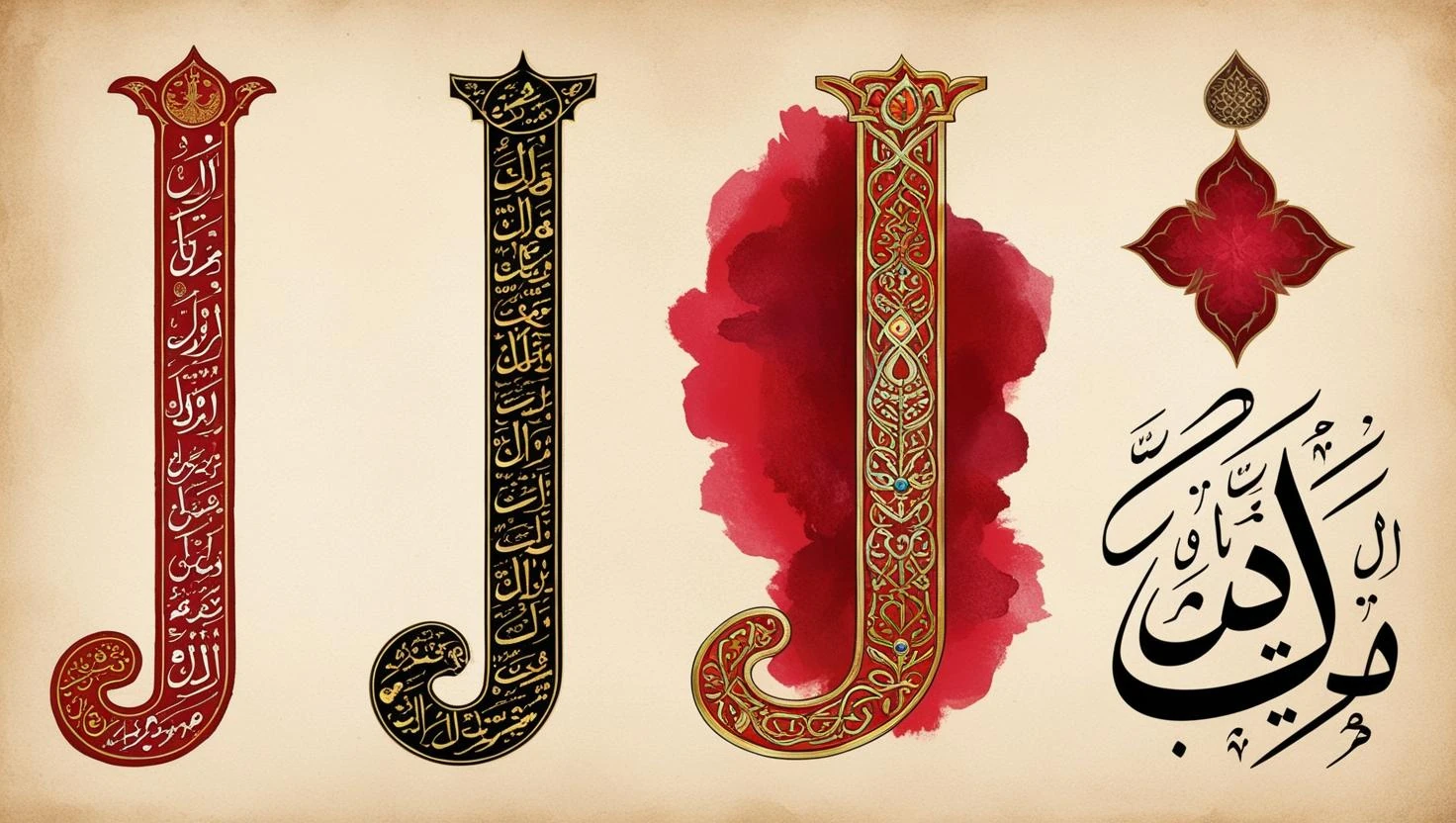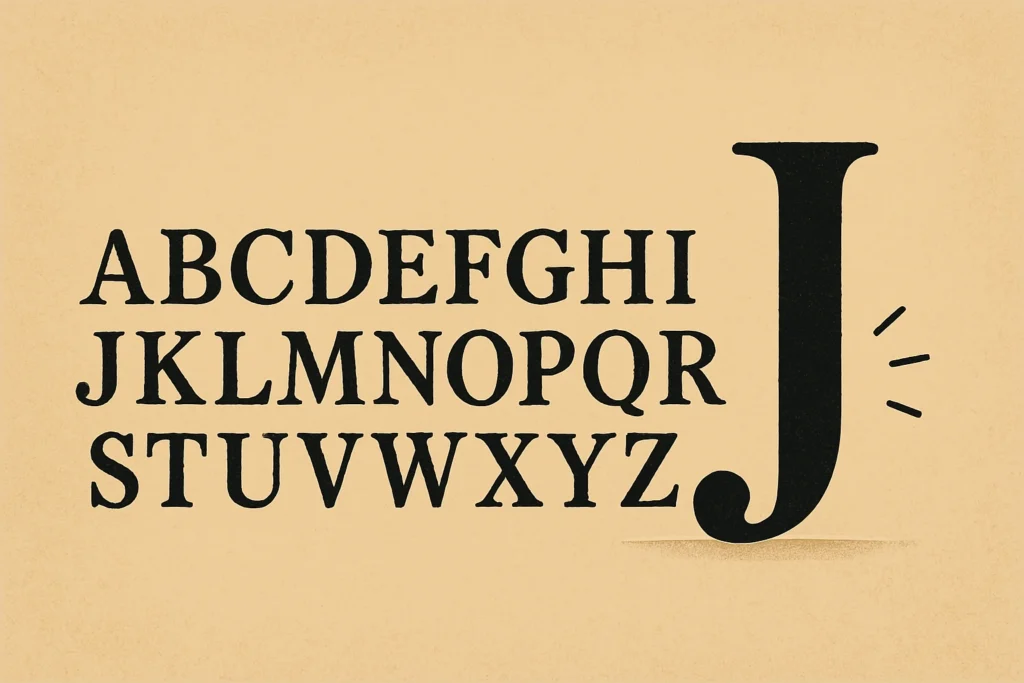
(AI Generated)
Ever noticed how Letter J feels like the odd one out in our alphabet? There’s actually a good reason for that! Letter J is basically the new kid on the block compared to most other letters we use every day. It’s pretty wild when you think about it – if you picked up an ancient Latin text, you’d search in vain for a single J anywhere. Not one! They simply didn’t exist back then. Kind of makes you wonder where this letter came from, right?
This little letter has such a cool backstory! Letter J started out as nothing more than a slightly modified version of I, but look at it now – we couldn’t imagine spelling “joy,” “journey,” or “justice” without it. Pretty impressive how it’s built its own identity, right?
When you think about it, J’s evolution actually shows us something bigger about how languages change over time. It’s not just some random typography trivia – it’s a perfect example of how our communication systems adapt and grow with us.
So how did this quirky hooked letter step out from the linguistic shadows to become the confident character we recognize today? That’s what I find fascinating. J’s journey isn’t just about a new symbol – it’s about how amazingly flexible human language can be as it evolves through the centuries.
How I Became Letter J: A Tale of Separation
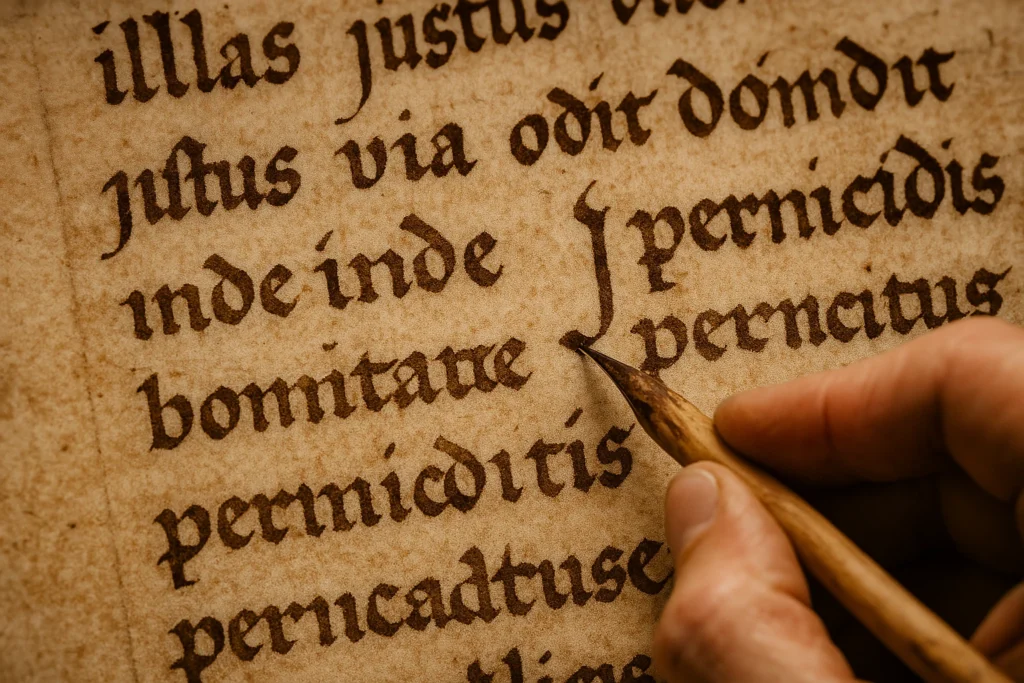
(AI Generated)
The birth of letter J is essentially a story of identity finding. For centuries, letter I and letter J shared not just a similar appearance but the same linguistic role. Ancient Romans used I for both vowel sounds (as in “island”) and consonant sounds (as in “yes”). They didn’t see a need for separate characters since context provided meaning.
Medieval scribes began making subtle distinctions, elongating the I when it functioned as a consonant. This slight change marked the first step toward separation. By the 1400s, you could really start to see the difference more clearly. Especially in handwritten stuff – that’s where scribes began giving the consonant I this little hook at the bottom.
If you look at manuscripts from that period, you can actually spot this happening! One monk would write an I one way, and when it was making a consonant sound, they’d add this little tail or flourish. It wasn’t standardized or anything – just a practical solution that developed naturally as people wrote. Kind of cool to think about someone’s casual pen stroke eventually becoming a whole new letter, isn’t it?
This separation wasn’t immediate or universal. Different languages adopted the distinction at different rates. The final push came with the invention of the printing press when standardization became necessary. Printers needed consistent rules, and separating these sounds into distinct letters provided clarity.
By the 1600s, people across Europe had pretty much settled on treating letter I and letter J as completely different letters. It wasn’t some overnight change – it took decades of messy transition where some writers used them interchangeably while others were strict about it.
Printers played a huge role in making this stick. They needed consistent rules for their typesets, and having separate boxes for letter I and letter J made their jobs easier. Plus, different countries adopted the change at different speeds – some jumped right on board while others dragged their feet for years.
It’s funny to think that for centuries, people got by just fine without letter J, and then suddenly they couldn’t imagine writing without it! Shakespeare’s early works often used I where we’d put letter J today, but by the end of his career, letter J was becoming the norm. I guess even the alphabet can have fashion trends, right?
The Hooked Letter: Visual Evolution of Letter J

(AI Generated)
The visual journey of letter J from a straight line to its distinctive hooked shape is a fascinating study of how writing evolves. Initially indistinguishable from I, J gradually developed its signature curve through centuries of handwriting adaptations.
Early manuscript writers would often add a slight flourish when I appeared at the beginning of words or when it represented a consonant sound. This decorative element served a practical purpose – it helped readers distinguish between different uses of what was essentially the same character.
By the Renaissance period, the hook became more pronounced. Calligraphers exaggerated the curve, creating a beautiful flowing line that descended below the baseline. This aesthetic choice eventually became a functional one. The elegant tail of letter J provided visual distinction that improved reading speed and comprehension.
Modern typographers have embraced J’s unique form. Its balanced curve contrasts nicely with the straight lines of many other letters, adding visual rhythm to the text. From the formal serifs of traditional fonts to the sleek simplicity of modern designs, letter J’s hook remains its defining characteristic – a visual reminder of its distinctive history.
The Only Letter Invented in Modern Times
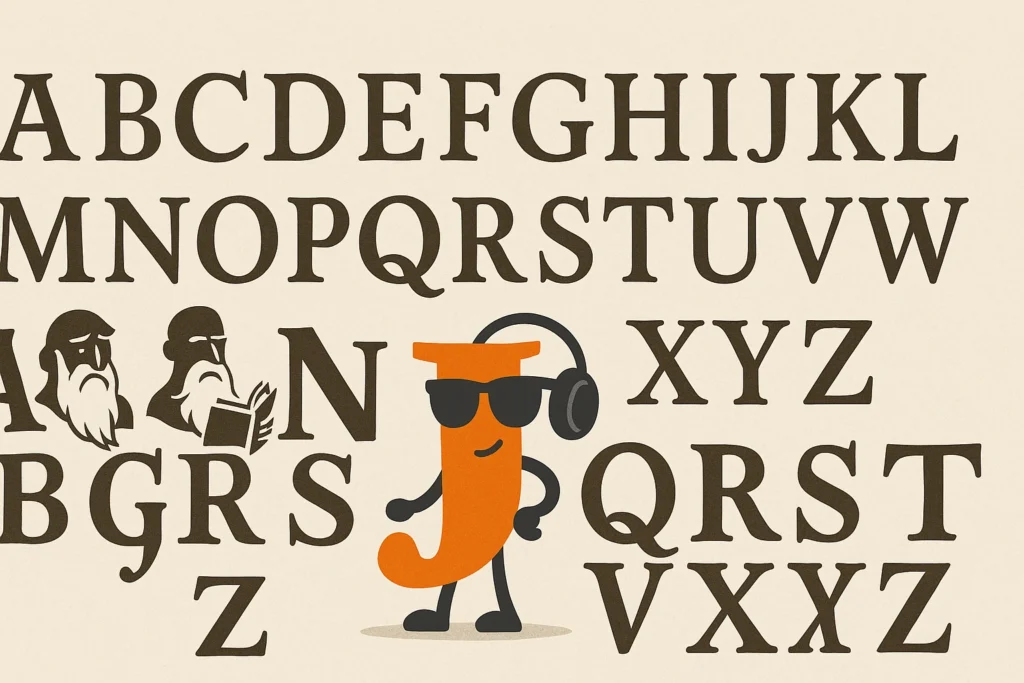
(AI Generated)
Unlike those ancient letters that go back to Phoenician, Greek, or Etruscan symbols from thousands of years ago, letter J is basically a teenager in alphabet years! It’s the only letter we use that was actually born in relatively recent times. Pretty wild, right?
When you think about it, J shows us something really interesting – languages keep changing even after they seem totally locked in place. We tend to think of letters are these permanent, unchanging things, but letter J proves that’s not true at all. Even something as basic as our ABCs can get a new addition when we need it!
I love this little linguistic rebel… imagine showing up super late to the alphabet party and still managing to become completely essential. That takes some serious letter chutzpah!
The modern letter J took definite shape during the Renaissance, making it practically a teenager compared to the ancient origins of letters like A, B, or O. While other letters gradually transformed from pictographic symbols over thousands of years, letter J emerged through deliberate differentiation in a relatively short timeframe.
This modern invention reflects a crucial shift in linguistic thinking. Rather than accepting ambiguity, scholars and printers sought precision and clarity. Letter J represents an early example of linguistic engineering – deliberately modifying language to improve communication efficiency.
The newness of J explains why it appears inconsistently in older texts. Shakespeare’s original folios often used I where we’d expect J today. This recent emergence also accounts for J’s varied pronunciation across languages – it simply hasn’t had as much time to standardize as other letters.
Why J Was Once Considered “Fake” Latin
Classical scholars initially resisted letter J as an upstart intruder, viewing it as an unnecessary corruption of pure Latin. In the traditional classical alphabet, I performed both functions perfectly well, and this division seemed artificial and even vulgar to linguistic purists.
Learned academics in medieval universities continued teaching Latin without J, considering it a modern contrivance beneath scholarly dignity. They pointed out that ancient Romans managed without it, so why complicate matters with new symbols? This resistance wasn’t merely aesthetic – it reflected deeper concerns about preserving cultural continuity.
The rehabilitation of letter J came gradually through practical use rather than academic endorsement. As vernacular languages gained prestige over classical ones, the practical benefits of distinguishing I and J became increasingly apparent. Printers, rather than professors, drove this change, finding that the distinction reduced ambiguity and made texts more accessible.
By the 18th century, even classical editions began incorporating J, though often with explanatory notes justifying this “modern” convention. Today, J is fully accepted in classical Latin transcriptions, though purists still occasionally note that Julius Caesar would have written his name as “IVLIVS CAESAR.”
J as a Sound Shifter: From Latin to Jazz
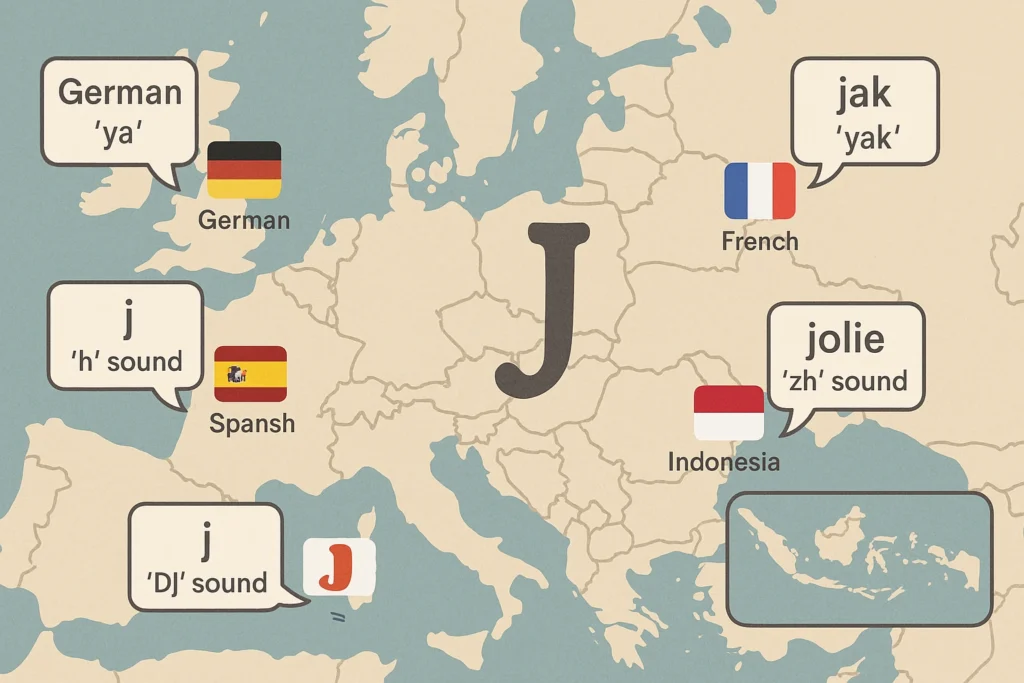
(AI Generated)
The pronunciation of J demonstrates remarkable versatility across languages and time periods. In classical Latin, the sound was closer to a semi-vowel “y” as in “year.” This pronunciation survives in Germanic languages like German, where “jung” (young) maintains this ancient connection.
Romance languages took J in different directions. Spanish preserved something close to the Latin “y” sound in words like “Juventud” (youth). The French softened it further to a “zh” sound as in “Jacques” or “jolie.” English developed its distinctive hard “j” sound (technically a voiced palato-alveolar affricate), heard in “jump” and “jelly.”
These sound shifts weren’t random but followed patterns of linguistic evolution. The transformation from a semi-vowel to various consonant sounds reveals how speech sounds naturally modify over generations. Neighboring sounds influence each other, and subtle shifts accumulate until entirely new pronunciations emerge.
The word “jazz” perfectly captures J’s journey – a relatively modern word with a distinctively modern letter, pronounced with a sound that didn’t exist in ancient languages. When we say words with J today, we’re participating in this ongoing sound evolution, still in progress after thousands of years.
The Joy and Jumble of J in World Languages
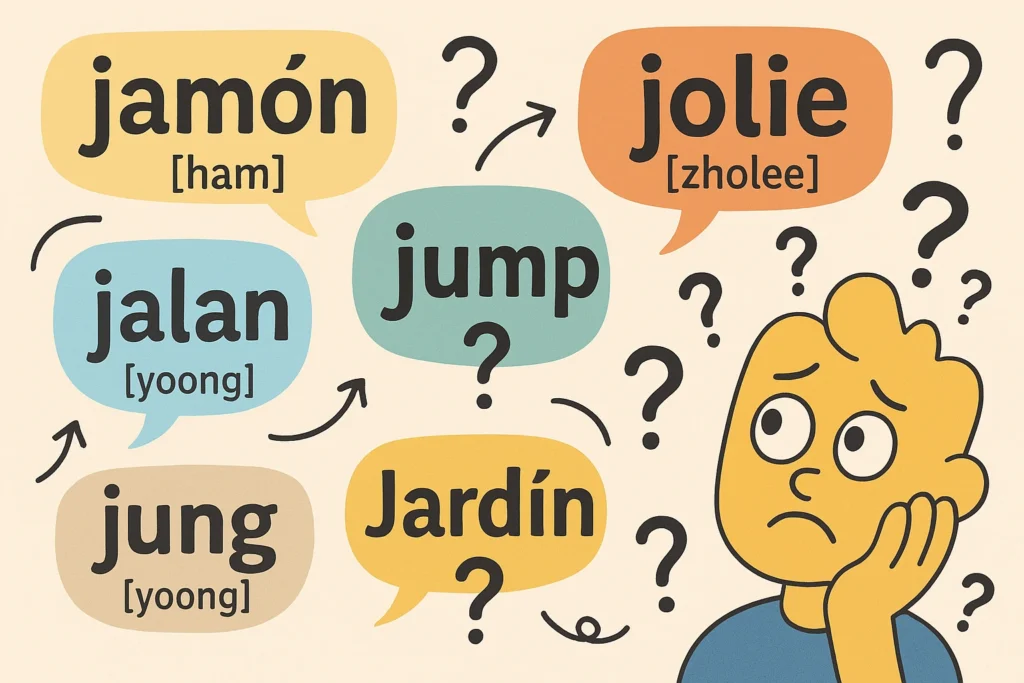
(AI Generated)
The way J bounces around different languages is a total headache for anyone trying to learn them! In Spanish, “jamón” sounds nothing like you’d expect – it’s got this breathy “h” sound that’ll throw you off completely. Meanwhile, Germans are over there saying “ja” like “ya,” which makes perfect sense once you know it, but good luck guessing that the first time!
It gets even weirder – Indonesians use J kind of like we do in English with that “DJ” sound, but then Vietnamese comes along and decides J should make a “z” sound. Who made these rules?!
These differences lead to some pretty funny mix-ups. I still remember my American friend in Spain flipping through a phone book for ages looking for “Javier” and getting increasingly frustrated. He had no clue he needed to check under “X” for “Xavier” instead! The look on his face when I told him was priceless – like the alphabet had personally betrayed him. And honestly, can you blame him? Same letter, completely different rules!
Some languages have embraced letter J wholeheartedly. English and French use it frequently, while others limit it to loan words. The Italian rarely uses J outside of foreign names. Finnish includes it officially, but primarily for words borrowed from other languages.
The Turkish language reform of the 1920s adopted letter J specifically for foreign words, showing how even writing systems can evolve to accommodate cross-cultural communication. This global variation reminds us that alphabets aren’t fixed systems but living tools that adapt to human needs across cultures and contexts.
The Role of J in English Spelling Oddities
English spelling presents numerous quirks involving J that puzzle even native speakers. Why does “judge” need a “d” before the letter J when the sound is already contained in the letter J itself? And why does “soldier” use no letter J at all despite having a clear J sound?
These inconsistencies stem from English’s complex history. When Norman French scribes began writing English words, they brought their own spelling conventions. The “dg” combination in words like “judge” reflects French influence, where additional letters helped clarify pronunciation.
Meanwhile, words like “gesture” and “soldier” preserved older spelling patterns despite pronunciation shifts. The letter “s” in “vision” and “pleasure” creates a letter J sound while keeping the original Latin roots intact. These linguistic fossils maintain their function as proof of language evolution because they contain evidence about how words have transformed throughout history in the same way actual fossils demonstrate evolutionary development in living organisms.
English speakers adopt words from other languages, such as “jalapeño” and “jihad,” without a set rule for maintaining their original spelling or altering them to fit English grammar. People tend to keep foreign spellings, including accent marks, because it demonstrates their global awareness by writing “jalapeño” correctly instead of “jalapeno”.
English displays its most intriguing characteristic through its irregular approach to handling words that come from other languages. English speakers either change words to fit our pronunciation rules or keep their original spelling to show respect and sophistication. The process of anglicization in borrowed words occurs at different speeds depending on the word and language, which makes language evolution unpredictable.
Names That Shaped the Power of Letter J
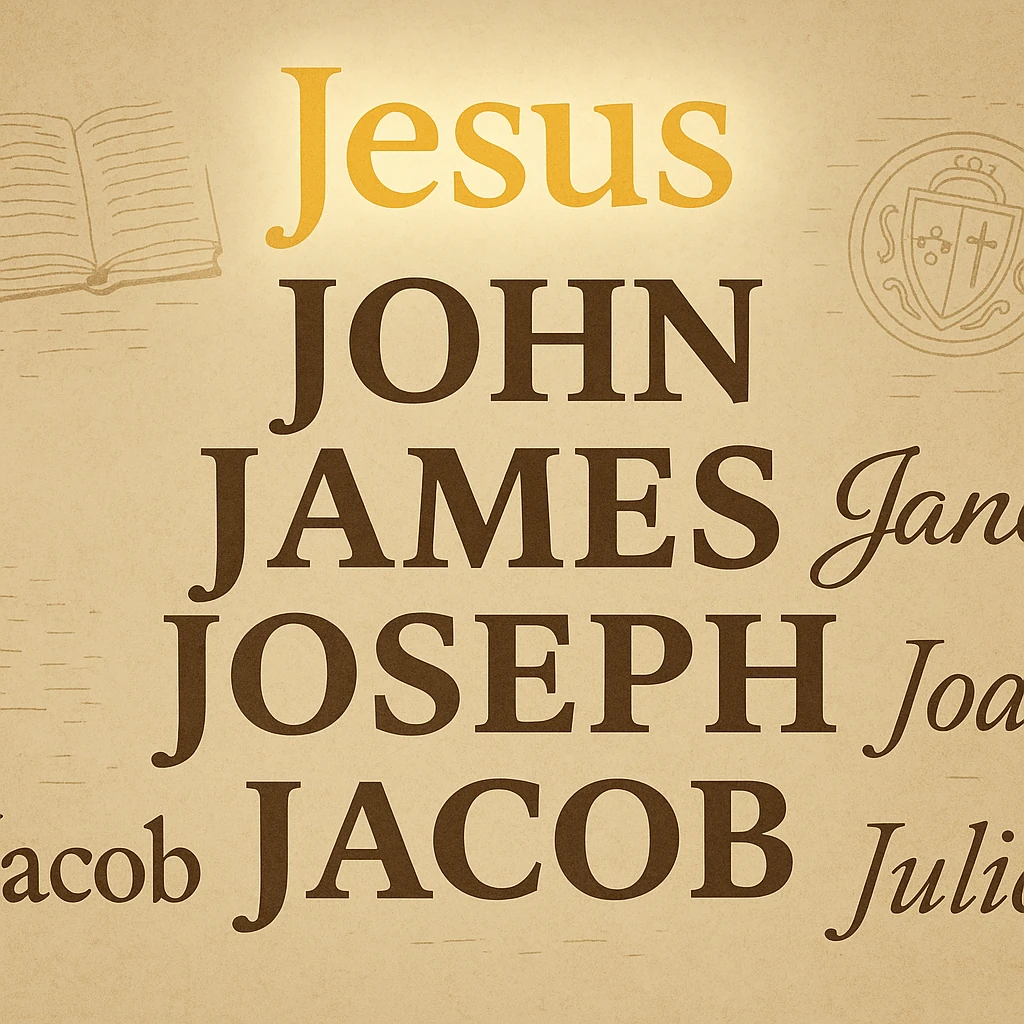
(AI Generated)
Personal names played a crucial role in establishing J’s importance in Western culture. The immense significance of the name Jesus (formerly written as Iesus) gave the letter spiritual weight. When biblical translations began using J consistently, it cemented the letter’s legitimacy.
John, James, Joseph, and Jacob – all names with tremendous cultural significance – reinforced J’s prominence. These weren’t just any names but names of patriarchs, saints, and kings. When James I became King of England in 1603, his name (rendered with a J) appeared on countless official documents, further normalizing the letter.
Female names like Jane, Joan, and Julie similarly strengthened letter J’s position. As literacy expanded, more people saw their own names written with this formerly rare letter, creating personal connections to it. This attachment to names helped overcome any lingering resistance to J as a legitimate letter.
Today, names beginning with the letter J remain notably popular across many Western countries. The letter’s relative newness may contribute to its perceived freshness and modernity in naming trends, showing how cultural factors continue shaping even something as basic as alphabet preference.
J in Pop Culture: From Jazz to JLo

(AI Generated)
The fashion world totally fell in love with J – just think about iconic brands like Jordans, Juicy Couture, and Jil Sander! There’s something about that curvy hook that makes for really eye-catching logos. It’s not just a coincidence that so many successful fashion labels start with J… that distinctive silhouette practically begs to be turned into a stylish brand mark.
And then tech culture took letter J to a whole new level! Java, jQuery, JavaScript – the internet as we know it basically runs on J-named programming stuff. Even your everyday photos are probably saved as JPEGs. It’s like J went from being the alphabet’s newest addition to completely dominating digital culture.
Isn’t it funny how even emoji culture got in on the J action? That “joy” emoji (😂) is practically the unofficial mascot of text messages worldwide! It’s consistently one of the most used emojis year after year.
When you step back and look at it, letter J has gone from being a linguistic latecomer to this powerhouse symbol of everything modern and innovative. Not bad for a letter that didn’t even exist a few centuries ago! Just goes to show how something can start as an afterthought and end up completely essential to culture.
Letter J Is for Justice: Symbolism in Social and Legal Discourse
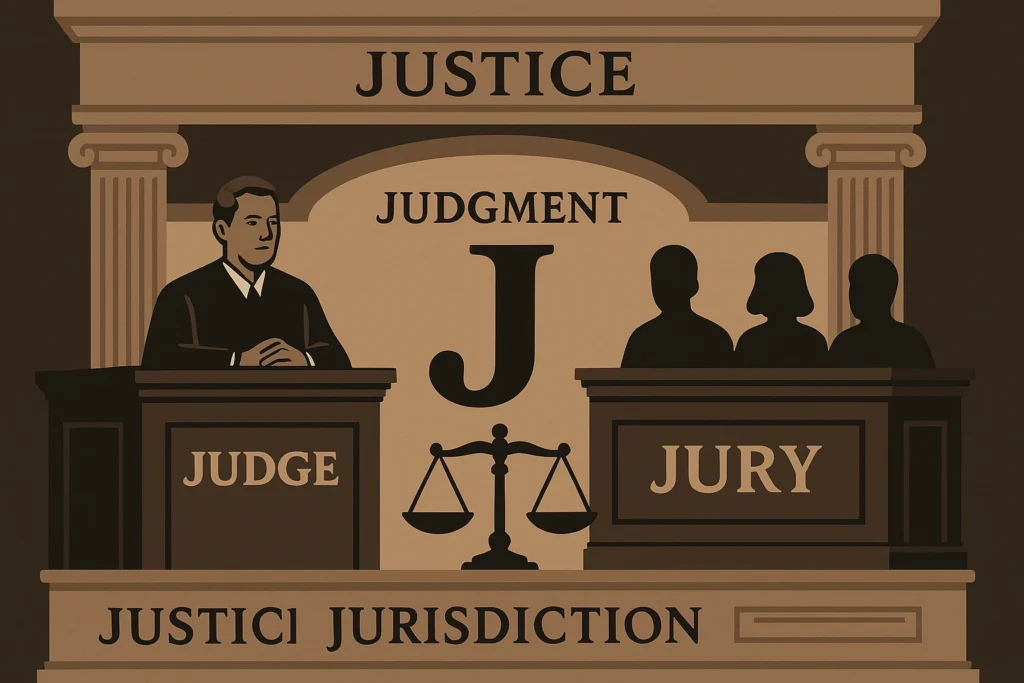
(AI Generated)
The words “justice,” “judgment,” “jury,” and “jurisdiction” basically form the backbone of legal systems everywhere English is spoken. It’s kinda wild when you think about it – so many crucial legal concepts all starting with the same letter! This isn’t just random chance either.
When you step into any courthouse, you’re surrounded by J-words at every turn. Judges wearing their robes, juries deliberating, jurisdictional questions being argued… It’s like the entire justice system got built around this one letter.
I’ve always found it interesting how some of our most serious and weighty concepts cluster around specific letters. The letter J somehow landed this role as the starter for words that deal with fairness, evaluation, and official authority. Makes you wonder if there’s something about that hard J sound that subconsciously signals importance and gravity to our ears.
Next time you watch a legal drama or get called for jury duty, notice how many times you hear J-words being thrown around. It’s almost like you can’t even talk about the law without constantly coming back to this relative newcomer to our alphabet!
Within legal documents, “J” shows up everywhere as the standard shorthand for “Judge” – it’s basically given the letter an official role in all court proceedings and legal citations. Flip through any law book or court filing and you’ll see J’s scattered throughout the margins and footnotes.
Supreme Court stuff takes it even further – justices get their last name with that little “J.” before it, like “Roberts, C.J.” for Chief Justice Roberts. The letter gets prime real estate in our most important legal documents!
I remember the first time I had to read a court opinion for a class and was completely baffled by all these random J’s floating around. Nobody explains this stuff to you – you’re just expected to somehow know that “Sotomayor, J., dissenting” means Justice Sotomayor wrote a dissenting opinion. It’s like a secret legal code that insiders recognize instantly while the rest of us are left scratching our heads.
Funny how a letter that was once considered an unnecessary addition to our alphabet now gets this place of honor in our most formal and serious documents, isn’t it?
The Letter J in Religion and Sacred Texts
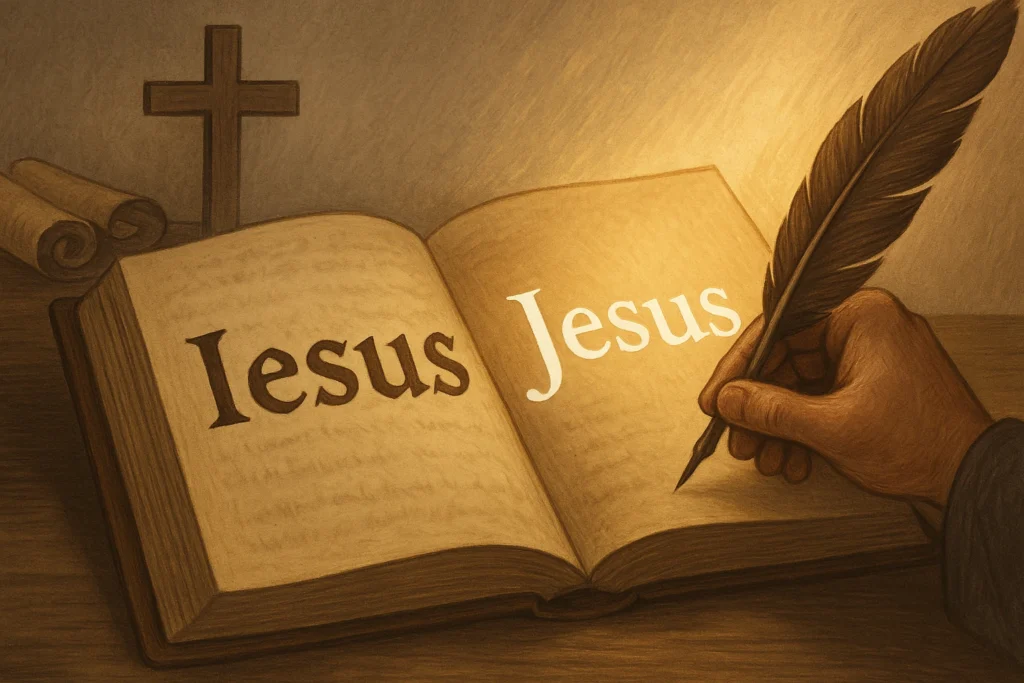
(AI Generated)
Religious traditions have complicated relationships with J, particularly regarding divine names. The Tetragrammaton (YHWH) in Hebrew was sometimes transliterated with a J, leading to “Jehovah” in some translations. This controversial rendering sparked theological debates that continue today.
The shift from “Iesus” to “Jesus” marked a significant transition in Christian texts. Early manuscripts and inscriptions use the I-form, while later translations adopted J. Some traditionalist denominations still prefer forms without J, seeing them as more authentic to original texts.
Islamic traditions generally avoid representing the divine name with J, though English translations sometimes use J-forms for prophets’ names. The name “Judas” acquired negative connotations in the Christian tradition, creating a rare instance where J begins a name with problematic associations.
Interestingly, in biblical numerology and gematria (assigning numeric values to letters), J presented challenges since it didn’t exist in the original alphabet. This absence required interpretive adjustments and created space for diverse theological perspectives on how to treat this newcomer to sacred language.
Typographic Playfulness: Designing with J
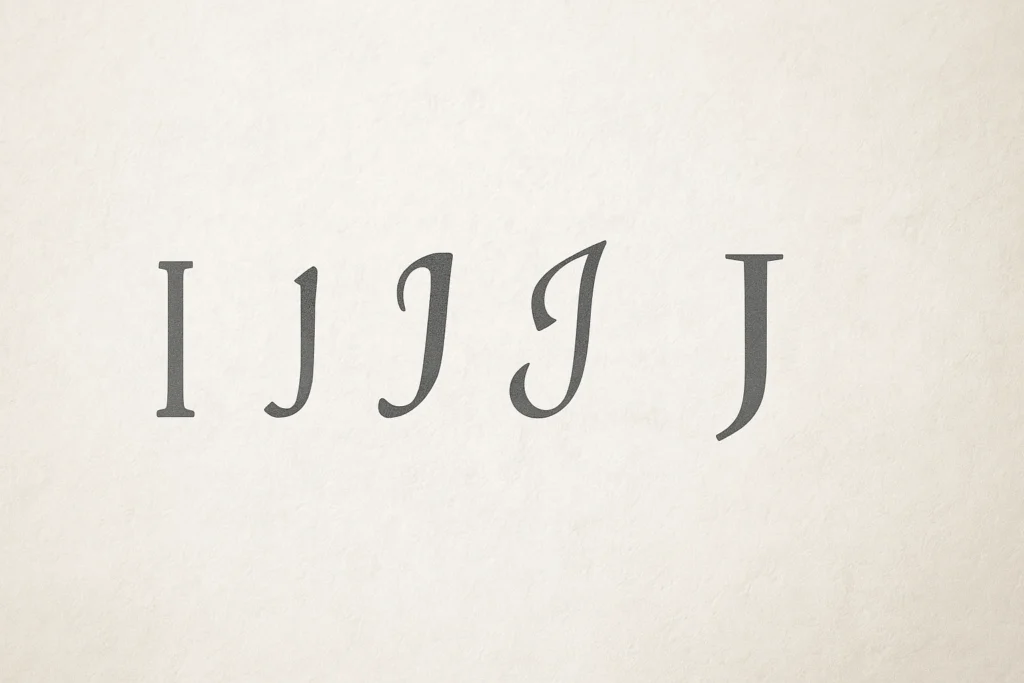
(AI Generated)
Typography designers often highlight J as one of the most expressive letters to work with. Its distinctive descender (the hook that drops below the baseline) provides vertical movement that breaks the monotony of the text. This feature creates rhythm and visual interest on the page.
In script and cursive fonts, J often receives special treatment. Calligraphers can extend their sweep dramatically, creating flourishes that showcase personal style. From elegant wedding invitations to graffiti tags, J offers opportunities for artistic expression rarely matched by other letters.
Logo designers frequently exploit J’s unique shape. Companies from Jeep to Jacuzzi leverage the letter’s distinctiveness. The hook can suggest action, motion, or strength, while the upper portion provides balance and stability. This duality makes J particularly valuable in visual identity systems.
Digital typography has further expanded creative possibilities. Animated typefaces can emphasize J’s curvature, making it swing or bounce in kinetic typography. This playfulness connects back to J’s relatively recent origin – as the youngest letter, it seems fitting that it often appears the most dynamic and modern.
Is J the Most Joyful Letter?

(AI Generated)
There’s something inherently upbeat about words beginning with J “Joy,” “jubilation,” “jolly,” and “jovial” all convey happiness and exuberance. This concentration of positive terms isn’t entirely coincidental – it reflects patterns of language development influenced by both sound and cultural associations.
The sound of J in English – that distinctive “dzh” – requires facial movements that slightly resemble the beginning of a smile. Phonologists note that articulating J engages facial muscles associated with positive expressions. This physical connection might subtly influence how we perceive J-words.
Children’s literature reinforces J’s cheerful associations. Characters like Jumping Jack, Joyful Jenny, or Jolly the Giraffe populate picture books. The bouncy action words that J begins – “jump,” “jiggle,” “jive” – lend themselves to playful storytelling and active games.
Even in color psychology, “jade” and “jasmine” evoke refreshing, positive sensations. Marketing researchers have noted that products with J-names often perform well in consumer testing for approachability and positive associations. Whether through sound symbolism or cultural reinforcement, J seems to have developed a personality more vibrant than many of its alphabetic companions.
Children and the Jump to J
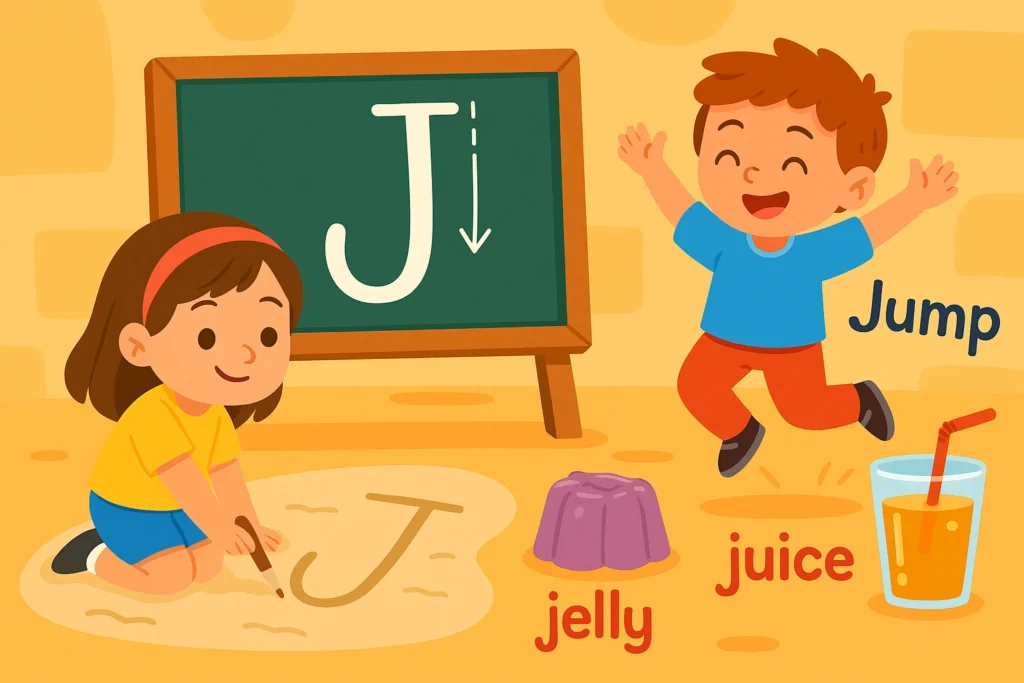
(AI Generated)
Learning to write J presents unique challenges for young children. Its combination of straight lines and curves requires more complex motor skills than simpler letters like I or L. Educators typically introduce J relatively late in handwriting instruction for this reason.
Confusion between J and other letters is common in early literacy. Children frequently reverse J and L, struggle with the difference between I and J, or write G with J-like features. These mistakes reflect both visual similarities and the conceptual challenge of understanding that J is both related to me and distinct from it.
Teaching strategies for J often involve kinesthetic activities. Children might “jump like J” or trace the letter in sand or shaving cream. These multisensory approaches help establish muscle memory for the letter’s distinctive shape. Words like “jelly,” “jump,” and “juice” provide an engaging vocabulary for J-centered lessons.
Interestingly, children learning languages with different J-sounds must navigate additional complexity. A bilingual child speaking both English and Spanish needs to understand that the same symbol makes different sounds in “jump” versus “jardin.” This flexibility builds cognitive strengths that extend beyond language skills.
Unexpected Uses of J in Science and Tech

(AI Generated)
Beyond everyday language, J serves specialized functions across scientific fields. In physics, ‘J’ represents electric current density, joules (a unit of energy), and angular momentum. These applications give the letter significant weight in equations that describe fundamental aspects of our universe.
Computer science has embraced J enthusiastically. Java remains one of the world’s most popular programming languages, while JavaScript powers much of the interactive web. The J programming language, though less known, offers unique approaches to array processing and mathematical functions.
In medicine, J-shaped curves describe important relationships between variables like blood pressure and mortality risk. Medical devices like J-wires and J-tubes incorporate the letter’s shape into their design and function, showing how a typographic form can inspire practical innovations.
Genetics uses ‘J’ in specific notation systems, while chemistry employs it in certain compound classifications. These specialized applications demonstrate how a symbol that emerged relatively recently in written language has become indispensable to our most advanced scientific understanding.
Famous Brands and the Magic of J

(AI Generated)
Marketing strategists have long recognized J’s distinctive appeal in branding. J.P. Morgan, Jeep, JBL, and J.Crew represent just a few successful examples. The letter projects confidence, creating a strong first impression with its bold visual presence.
The brevity of letter J makes it ideal for modern brand environments where space is limited. Single-letter abbreviations like J. Crew compress longer names while maintaining brand recognition. In mobile interfaces and app icons, J’s distinctive shape remains recognizable even at small sizes.
Luxury brands particularly favor letter J – Jaguar, Jimmy Choo, and Judith Leiber position their products at premium price points. The letter’s relative rarity (it’s one of the least frequently used in English) contributes to perceptions of exclusivity and distinction.
Even products targeting younger demographics employ letter J effectively. Jansport, Jif, and Jamba Juice demonstrate the letter’s versatility across age segments. This broad appeal makes J a valuable asset in naming strategies, offering instant memorability without the overexposure of more common initial letters.
J: From the Edge of the Alphabet to the Center of Identity

(AI Generated)
Despite its late arrival to the alphabet, letter J has traveled from marginal status to cultural significance with remarkable speed. Once dismissed as unnecessary, it now initiates words central to our legal systems, religious traditions, and personal identities.
The journey of letter J mirrors broader patterns of cultural evolution. Initially resisted as an innovation, it gradually proved its value through practical application. This pattern – initial skepticism followed by enthusiastic adoption – characterizes many transformative developments in human communication.
Today, letter J straddles multiple identities. It remains the youngest letter while simultaneously feeling established and essential. Its varied pronunciations across languages highlight both the persistence of ancient patterns and the inevitability of linguistic change. Few symbols better illustrate how language adapts to human needs while preserving connections to our shared past.
Perhaps J’s true magic lies in this dual nature – looking backward to its origins as a variant of I while pointing forward to endless innovations in how we communicate. In a single hooked symbol, we can trace the remarkable story of human ingenuity, adaptability, and our endless capacity to create meaningful distinctions in our shared symbolic systems.
Words That Begin With Letter J
J jolts language with joy and jest — a late bloomer in the alphabet, but full of spark:
- Journey – Every learning path or project starts with a single step. Explore journey symbolism
- Justice – A timeless concept rooted in fairness, balance, and truth. What is justice
- Job – The basic unit of effort and income, whether freelance or full-time. Find online jobs
Words That Begin With Letter I
letter I stands tall — symbolizing identity, integrity, and innovation. These I-words echo their upright essence:
- Income – The reward of consistent work, especially online and independent. Income ideas
- Influence – The power to shape thoughts, trends, and culture. Social influence
- Intuition – The silent signal that often guides us right. Science of intuition
Continue Your Alphabet Journey
Explore More Letters:
A | B | C | D | E | F | G | H | I | J | K | L | M | N | O | P | Q | R | S | T | U | V | W | X | Y | Z
Share this article:
Did you enjoy learning about the letter J? Share your thoughts in the comments below or spread the knowledge by sharing this article with fellow language enthusiasts!
